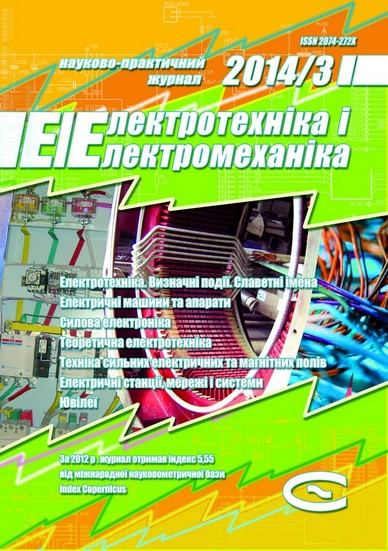NUMERICAL SIMULATION OF SPARK DISCHARGE CHARACTERISTICS IN LIQUID NITROGEN
DOI:
https://doi.org/10.20998/2074-272X.2014.3.12Keywords:
spark discharge, liquid nitrogen, spatial and temporal characteristicsAbstract
In MHD approximation, a mathematical model of spark discharge in liquid nitrogen is worked out on the basis of data generalization pertaining to thermodynamical functions and mass-transfer coefficients in a wide parameter range. The results obtained are used for analysis of both integral and spatial-temporal discharge characteristics important for practical application.
References
Tabuchi M., Kaneko Ya., Iwasaki H. Synthesis of titanium nitride powder by spark discharge process in liquid nitrogen. Journal of the Ceramic Society of Japan, 1990, vol.98, no.12, pp. 1296-1301.
Filatov G.P., Soloviev M.A., Kuretz V.I. Destruction of polymers in liquid nitrogen by the electrical discharge. 14th Symposium on high current electronics. Tomsk, HCEI Publ., 2006, pp. 434-436.
Kuskova N.I., Dubovenko K.V., Petrichenko S.V., Tsolin P.L., Chaban S.O. Electrodischarge technology and equipment to produce new carbon nanomaterials. Surface engineering and applied electrochemistry, 2013, vol.49, no.3, pp. 35-42.
Yuferov V.B., Ozerov A.N., Vinnikov D.V., Buravilov I.V., Ponomarev A.N. Elektroimpul'snoe izmel'chenie elastichnyh materialov v srede zhidkogo azota. Bulletin of NTU "KhPІ", 2012, no.52(958), pp. 202-209.
Konovalov K.B. Processy sinteza i izmel'chenija sverhmolekuljarnyh polimerov vysshih α-olefinov i apparaty dlja ih realizacii. Avtoref. diss. kand. tehn. nauk. Tomsk, 2013. 20 p.
Shvets I.S. K opredeleniju udel'noj elektroprovodnosti plazmy podvodnogo iskrovogo razrjada. Teplofizika vysokih temperature, 1980, vol.18, no.1, pp. 1-8.
Dubovenko K.V. Vzaimodejstvie udarnyh voln s plazmoj kanala sil'notochnogo razrjada v kamere vysokogo davlenija. Zhurnal. tehnicheskoy fiziki, 1992, vol.62, no.6, pp. 83-93.
Dubovenko K.V. Allowance for the interaction between the underwater electric discharge channel plasma and the shock wave reflected from the chamber's wall. Surface engineering and applied electrochemistry, 2013, vol.49, no.1, pp. 28-35.
Dubovenko K.V. Numerical simulation of the underwater spark discharge spatial and temporal characteristics. Electrical engineering & electromechanics, 2010, no.1, pp. 38-42.
Sychev V.V., Vasserman A.A., Kozlov A.D., Spiridonov G.A., Cymarnyj V.A. Termodinamicheskie svojstva azota. Moscow, Izd-vo standartov Publ., 1977. 352 p.
Azot. Kojefficienty dinamicheskoj vjazkosti i teploprovodnosti pri temperaturah 65-1000 K i davlenijah ot sostojanija razrezhennogo gaza do 200 MPa: GSSSD 89-85. Tablicy standartnyh spravochnyh dannyh. Moscow, Izd-vo standartov Publ., 1986. 21 p.
Span R., Lemmon E.W., Jacobson R.T., Wagner W., Yokozeki A.A. Reference equation of state for the thermodynamic properties of nitrogen for temperatures from 63.151 to 1000 K and pressures to 2200 MPa. J. Phys Che. Ref. Data, 2000, vol.29, no.6, pp. 1361-1433.
Kalitkin N.N., Kuz'mina L.V., Rogov V.S. Tablicy termodinamicheskih funkcij i transportnyh kojefficientov plazmy. Moscow, Applied Mathematics Institute of AN USSR, Preprint no.34. 112 p.
Samarskij A.A., Popov Ju.P. Raznostnye metody reshenija zadach gazovoj dinamiki. Moscow, Nauka Publ., 1980. 352 p.
Downloads
Published
How to Cite
Issue
Section
License
Copyright (c) 2015 K. V. Dubovenko

This work is licensed under a Creative Commons Attribution-NonCommercial 4.0 International License.
Authors who publish with this journal agree to the following terms:
1. Authors retain copyright and grant the journal right of first publication with the work simultaneously licensed under a Creative Commons Attribution License that allows others to share the work with an acknowledgement of the work's authorship and initial publication in this journal.
2. Authors are able to enter into separate, additional contractual arrangements for the non-exclusive distribution of the journal's published version of the work (e.g., post it to an institutional repository or publish it in a book), with an acknowledgement of its initial publication in this journal.
3. Authors are permitted and encouraged to post their work online (e.g., in institutional repositories or on their website) prior to and during the submission process, as it can lead to productive exchanges, as well as earlier and greater citation of published work.





